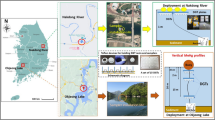Abstract
Mercury pollution has become one of the serious ecological and health problems in developing countries. In aquatic environments, widespread dissolved organic matter (DOM) affects the physical transfer, chemical transformation and bioavailability of heavy metal ions. In the arid inland lakes, water salinity has been increasing due to close hydrological system and much higher vaporization than precipitation, and thus there are usually salinity gradients in these inland lakes. The change of salinity may exert influences on complexation of DOM with heavy metals. However, response of the metal complexation of DOM to the salinity is still unclear. In this study, three-dimensional molecule fluorescence spectroscopy (3D-EEM) was used to examine the interaction of Hg(II) and DOM in sediment along a salinity gradient of the Bosten Lake, the biggest inland freshwater lake in China. Three fluorescence peaks were identified in the EEM fluorescence spectra of all DOM samples. All the three fluorescence peaks could be quenched by Hg(II), indicating the formation of stable nonluminous DOM-Hg complexes. The conditional stability constant and binding constant for DOM-Hg(II) were 3.82–4.34 and 3.76–5.54, respectively. Conditional stable constants and binding constants for the system of Hg(II) and protein-like substances were higher than those for the humic substances-Hg(II) system. The ligand ratio of fluorophore to Hg(II) correlated well with the salinity. The strong complexation of Hg(II) and DOM and its responses to salinity change may significantly influence transport, transformation and ecological risk of Hg in Bosten Lake.
Similar content being viewed by others
References
C. G. Bai, G. J. Mu, J. Wang, “Grain-size fractal dimensions characteristics of lacustrine sediments of Aiby Lake and the environmental significance,” Arid Land Geography 4, 336–341 (2002)
M. Leermakers, C. Meuleman, and W. Baeyens, “Mercury speciation in the Scheldt estuary,” Water Air Soil Poll. 80, 641–652 (1995).
S. A. Wood, “The role of humic substances in the transport and fixation of metals of economic interests (Au, Pt, Pd, U, V),” Ore Geol. Rev. 11 1–31.
H. L. Xu, Y. P. Guo, and W. H. Li, “Analysis on the water pollution in Bosten Lake, Xinjiang,” Arid Zone Res. 20(3), 192–196 (2003).
C. A. Mopperk and C. A. Schultz, “Fluorescence as a possible tool for studying the nature and water column distribution of DOC components,” Mar. Chem. 41, 229–238 (1993).
E. Ymashita and E. Tanoue, “Chemical characterization of protein like fluorescence in DOM in relation to aromatic amino acids,” Mar. Chem. 82, 255–271 (2003).
R. Wufuer, Y. Liu, A. M. Bao, et al., “3D fluorescence spectroscopy of the dissolved organic matter in the sediment pore water of the Bosten Lake,” Arid Zone Res. (in press).
W. Chen, P. Westerhoff, and J. Leenheer, “Fluorescence excitation-emission matrix regional integration to quantify spectra for dissolved organic matter,” Environ. Sci. Technol. 37(24), 5701–5710 (2003).
X. L. Pan, J. Y. Yang, and D. Y. Zhang, “Cu(II) complexation of high molecular weight (HMW) fluorescent substances in root exudates from a wetland halophyte,” J. Biosci. Bioeng. 111(2), 193–197 (2011).
F. Wu and E. Tanoue, “Isolation and partial characterization of dissolved copper-complexing ligands in streamwaters,” Environ. Sci. Technol. 35(18), 3646–3652 (2001).
G. P. Sheng and H. Q. Yu, “Characterization of extra-cellular polymeric substances of aerobic and anaerobic sludge using 3-dimensional fluorescence spectroscopy,” Water Res. 40, 1233–1239 (2006).
F. Ding, G. Y. Zhao, S. C. Chen, et al., “Chloramphenicol constants and binding sites by steady-state fluorescence,” J. Mol. Struct. 929(3), 159–166 (2009).
P. Q. Fu, F. C. Wu, C. Q. Liu, et al., “Fluorescence characterization of dissolved organic matter in an urban river and its complexation with Hg(II), Appl. Geochem. 22, 1667–1679 (2007).
X. L. Pan, J. Liu, and D. Y. Zhang, “Binding of phenanthrene to extracellular polymeric substances (EPS) from aerobic activated sludge: a fluorescence study,” Colloid Surf. B 80(1), 103–106 (2010).
Q. L. Xiao and R. Jaffe, “Interaction between Hg(II) and natural dissolved organic matter: a fluorescence spectroscopy based study,” Water Resour. 35(3) 1793–1803 (2001).
Weber, “Comparison of spectrofluorometry and ion-selective electrode potentiometry for determination of complexes between fulvic acid and heavy-metal ions,” Anal. Chem. 52, 2095–2100 (1980).
X. S. he, B. D. Xi, Z. M. Wei, et al., “Three-dimensional fluorescence spectroscopic characterization of complexation between mercury and dissolved organic matter extracted from landfill leachate,” Anal. Chem. 38, 1417–1422 (2001).
T. L. Hill, Cooperativity Therory in Biochemistry (Springer-Verlag, New York, 1985).
L. Zhang, A. Z. Ding, J. Wang, et al., “Adsorption characteristics of Cd2+ and Zn2+ by extracellular polymeric substances with varied constituents from activated sludge,” Environ. Chem. 29(10), 2850–2855 (2008).
Author information
Authors and Affiliations
Corresponding authors
Additional information
The article is published in the original.
Rights and permissions
About this article
Cite this article
Wufuer, R., Liu, Y., Mu, S. et al. Interaction of dissolved organic matter with Hg(II) along salinity gradient in Boston Lake. Geochem. Int. 52, 1072–1077 (2014). https://doi.org/10.1134/S001670291412009X
Received:
Published:
Issue Date:
DOI: https://doi.org/10.1134/S001670291412009X




